如何用 Java 几分钟处理完 30 亿个数据?
共 8930字,需浏览 18分钟
· 2022-07-06
往期热门文章:
1、计算机专业会不会成为下一个土木? 2、xxl-job惊艳的设计,怎能叫人不爱 3、ArrayList#subList这四个坑,一不小心就中招 4、面试官:大量请求 Redis 不存在的数据,从而影响数据库,该如何解决? 5、包装类这颗语法糖,其实并不甜 转自:Dream_it_possible!, 链接:blog.csdn.net/qq_33036061/article/details/124568689
1. 场景说明
现有一个 10G 文件的数据,里面包含了 18-70 之间的整数,分别表示 18-70 岁的人群数量统计。假设年龄范围分布均匀,分别表示系统中所有用户的年龄数,找出重复次数最多的那个数,现有一台内存为 4G、2 核 CPU 的电脑,请写一个算法实现。
23,31,42,19,60,30,36,........2. 模拟数据
Java 中一个整数占 4 个字节,模拟 10G 为 30 亿左右个数据, 采用追加模式写入 10G 数据到硬盘里。
每 100 万个记录写一行,大概 4M 一行,10G 大概 2500 行数据。
package bigdata;import java.io.*;import java.util.Random;/*** @Desc:* @Author: bingbing* @Date: 2022/5/4 0004 19:05*/public class GenerateData {private static Random random = new Random();public static int generateRandomData(int start, int end) {return random.nextInt(end - start + 1) + start;}/*** 产生10G的 1-1000的数据在D盘*/public void generateData() throws IOException {File file = new File("D:\\ User.dat");if (!file.exists()) {try {file.createNewFile();} catch (IOException e) {e.printStackTrace();}}int start = 18;int end = 70;long startTime = System.currentTimeMillis();BufferedWriter bos = new BufferedWriter(new OutputStreamWriter(new FileOutputStream(file, true)));for (long i = 1; i < Integer.MAX_VALUE * 1.7; i++) {String data = generateRandomData(start, end) + ",";bos.write(data);// 每100万条记录成一行,100万条数据大概4Mif (i % 1000000 == 0) {bos.write("\n");}}System.out.println("写入完成! 共花费时间:" + (System.currentTimeMillis() - startTime) / 1000 + " s");bos.close();}public static void main(String[] args) {GenerateData generateData = new GenerateData();try {generateData.generateData();} catch (IOException e) {e.printStackTrace();}}}
上述代码调整参数执行 2 次,凑 10G 数据在 D 盘 User.dat 文件里:
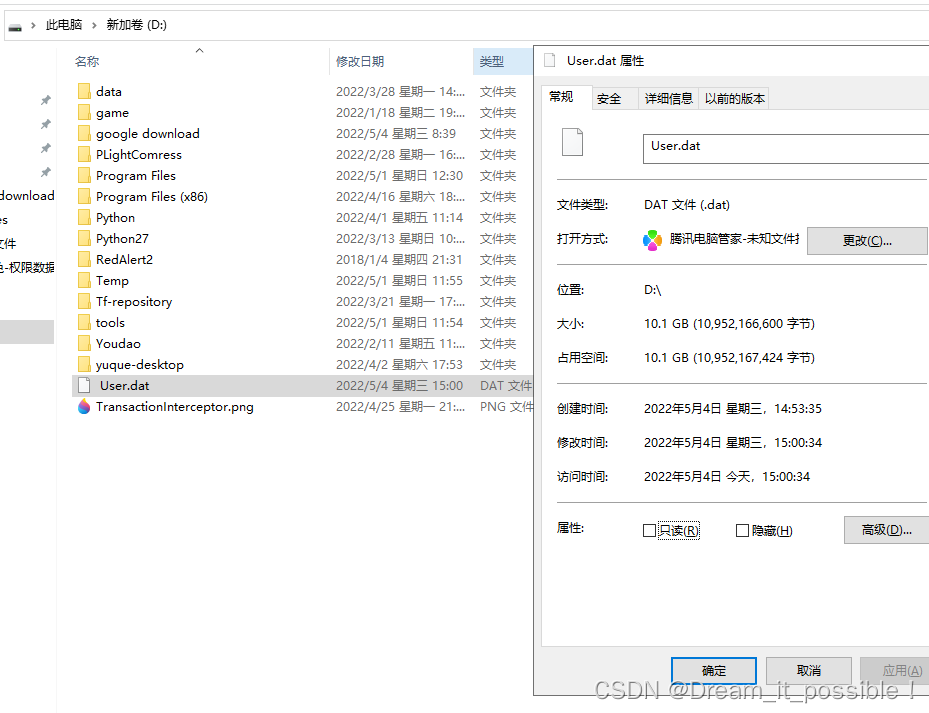
准备好 10G 数据后,接着写如何处理这些数据。
3. 场景分析
10G 的数据比当前拥有的运行内存大的多,不能全量加载到内存中读取。如果采用全量加载,那么内存会直接爆掉,只能按行读取。Java 中的 bufferedReader 的 readLine() 按行读取文件里的内容。
4. 读取数据
首先,我们写一个方法单线程读完这 30 亿数据需要多少时间,每读 100 行打印一次:
private static void readData() throws IOException {BufferedReader br = new BufferedReader(new InputStreamReader(new FileInputStream(FILE_NAME), "utf-8"));String line;long start = System.currentTimeMillis();int count = 1;while ((line = br.readLine()) != null) {// 按行读取if (count % 100 == 0) {System.out.println("读取100行,总耗时间: " + (System.currentTimeMillis() - start) / 1000 + " s");System.gc();}count++;}running = false;br.close();}
按行读完 10G 的数据大概 20 秒,基本每 100 行,1 亿多数据花 1 秒,速度还挺快。
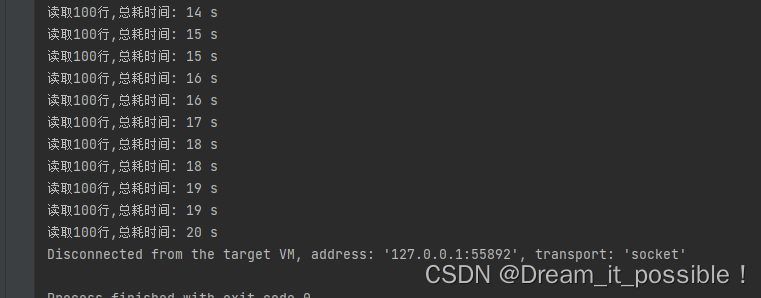
5. 处理数据
5.1 思路一
通过单线程处理,初始化一个 countMap,key 为年龄,value 为出现的次数。将每行读取到的数据按照 "," 进行分割,然后获取到的每一项进行保存到 countMap 里。如果存在,那么值 key 的 value+1。
for (int i = start; i <= end; i++) {try {File subFile = new File(dir + "\\" + i + ".dat");if (!file.exists()) {subFile.createNewFile();}countMap.computeIfAbsent(i + "", integer -> new AtomicInteger(0));} catch (FileNotFoundException e) {e.printStackTrace();} catch (IOException e) {e.printStackTrace();}}
单线程读取并统计 countMap:
publicstatic void splitLine(String lineData) {String[] arr = lineData.split(",");for (String str : arr) {if (StringUtils.isEmpty(str)) {continue;}countMap.computeIfAbsent(str, s -> new AtomicInteger(0)).getAndIncrement();}}
通过比较找出年龄数最多的年龄并打印出来:
private static void findMostAge() {Integer targetValue = 0;String targetKey = null;Iterator<Map.Entry<String, AtomicInteger>> entrySetIterator = countMap.entrySet().iterator();while (entrySetIterator.hasNext()) {Map.Entry<String, AtomicInteger> entry = entrySetIterator.next();Integer value = entry.getValue().get();String key = entry.getKey();if (value > targetValue) {targetValue = value;targetKey = key;}}System.out.println("数量最多的年龄为:" + targetKey + "数量为:" + targetValue);}
测试结果
总共花了 3 分钟读取完并统计完所有数据。
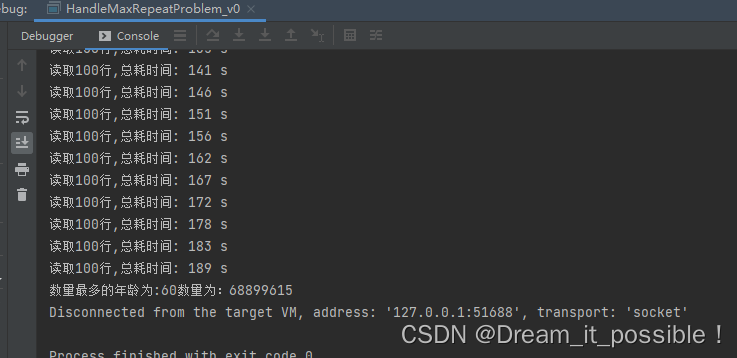
内存消耗为 2G-2.5G,CPU 利用率太低,只向上浮动了 20%-25% 之间。
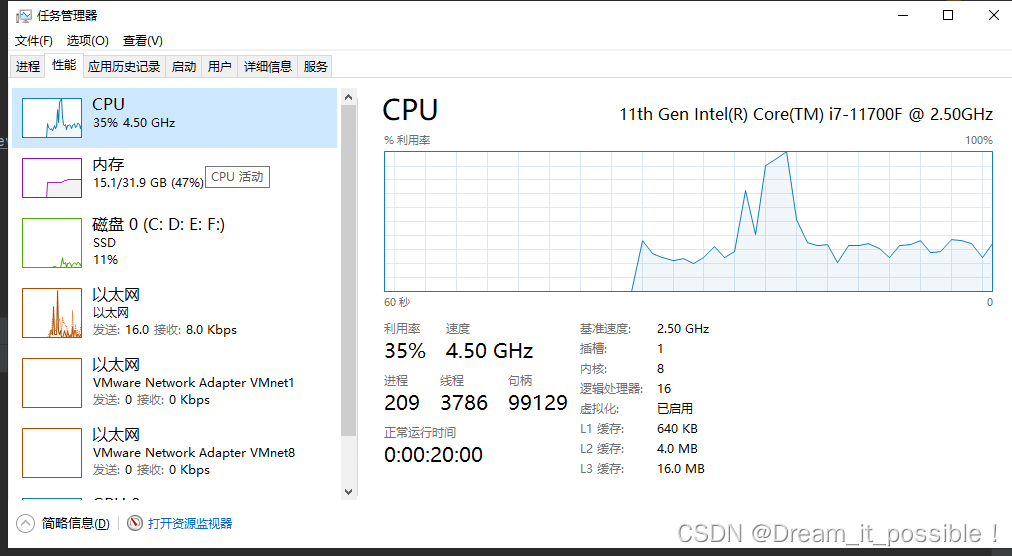
要想提高 CPU 利用率,那么可以使用多线程去处理。
下面我们使用多线程去解决这个 CPU 利用率低的问题。
5.2 思路二:分治法
使用多线程去消费读取到的数据。采用生产者、消费者模式去消费数据。
因为在读取的时候是比较快的,单线程的数据处理能力比较差。因此思路一的性能阻塞在取数据的一方且又是同步操作,导致整个链路的性能会变的很差。
所谓分治法就是分而治之,也就是说将海量数据分割处理。根据 CPU 的能力初始化 n 个线程,每一个线程去消费一个队列,这样线程在消费的时候不会出现抢占队列的问题。同时为了保证线程安全和生产者消费者模式的完整,采用阻塞队列。Java 中提供了 LinkedBlockingQueue 就是一个阻塞队列。

初始化阻塞队列
使用 LinkedList 创建一个阻塞队列列表:
private static List<LinkedBlockingQueue<String>> blockQueueLists = new LinkedList<>();在 static 块里初始化阻塞队列的数量和单个阻塞队列的容量为 256。
上面讲到了 30 亿数据大概 2500 行,按行塞到队列里。20 个队列,那么每个队列 125 个,因此可以容量可以设计为 256 即可。
//每个队列容量为256for (int i = 0; i < threadNums; i++) {blockQueueLists.add(new LinkedBlockingQueue<>(256));}
生产者
为了实现负载的功能,首先定义一个 count 计数器,用来记录行数:
private static AtomicLong count = new AtomicLong(0);按照行数来计算队列的下标 long index=count.get()%threadNums。
下面算法就实现了对队列列表中的队列进行轮询的投放:
static class SplitData {public static void splitLine(String lineData) {String[] arr = lineData.split("\n");for (String str : arr) {if (StringUtils.isEmpty(str)) {continue;}long index = count.get() % threadNums;try {// 如果满了就阻塞blockQueueLists.get((int) index).put(str);} catch (InterruptedException e) {e.printStackTrace();}count.getAndIncrement();}}
消费者
1) 队列线程私有化
消费方在启动线程的时候根据 index 去获取到指定的队列,这样就实现了队列的线程私有化。
private static void startConsumer() throws FileNotFoundException, UnsupportedEncodingException {//如果共用一个队列,那么线程不宜过多,容易出现抢占现象System.out.println("开始消费...");for (int i = 0; i < threadNums; i++) {final int index = i;// 每一个线程负责一个 queue,这样不会出现线程抢占队列的情况。new Thread(() -> {while (consumerRunning) {startConsumer = true;try {String str = blockQueueLists.get(index).take();countNum(str);} catch (InterruptedException e) {e.printStackTrace();}}}).start();}}
2) 多子线程分割字符串
由于从队列中多到的字符串非常的庞大,如果又是用单线程调用 split(",") 去分割,那么性能同样会阻塞在这个地方。
// 按照 arr的大小,运用多线程分割字符串private static void countNum(String str) {int[] arr = new int[2];arr[1] = str.length() / 3;for (int i = 0; i < 3; i++) {final String innerStr = SplitData.splitStr(str, arr);new Thread(() -> {String[] strArray = innerStr.split(",");for (String s : strArray) {countMap.computeIfAbsent(s, s1 -> new AtomicInteger(0)).getAndIncrement();}}).start();}}
3) 分割字符串算法
分割时从 0 开始,按照等分的原则,将字符串 n 等份,每一个线程分到一份。
用一个 arr 数组的 arr[0] 记录每次的分割开始位置。arr[1] 记录每次分割的结束位置,如果遇到的开始的字符不为 "," 那么就 startIndex-1。如果结束的位置不为 "," 那么将 endIndex 向后移一位。
如果 endIndex 超过了字符串的最大长度,那么就把最后一个字符赋值给 arr[1]。
/*** 按照 x坐标 来分割 字符串,如果切到的字符不为“,”, 那么把坐标向前或者向后移动一位。** @param line* @param arr 存放x1,x2坐标* @return*/public static String splitStr(String line, int[] arr) {int startIndex = arr[0];int endIndex = arr[1];char start = line.charAt(startIndex);char end = line.charAt(endIndex);if ((startIndex == 0 || start == ',') && end == ',') {arr[0] = endIndex + 1;arr[1] = arr[0] + line.length() / 3;if (arr[1] >= line.length()) {arr[1] = line.length() - 1;}return line.substring(startIndex, endIndex);}if (startIndex != 0 && start != ',') {startIndex = startIndex - 1;}if (end != ',') {endIndex = endIndex + 1;}arr[0] = startIndex;arr[1] = endIndex;if (arr[1] >= line.length()) {arr[1] = line.length() - 1;}return splitStr(line, arr);}
测试结果
内存和 CPU 初始占用大小:
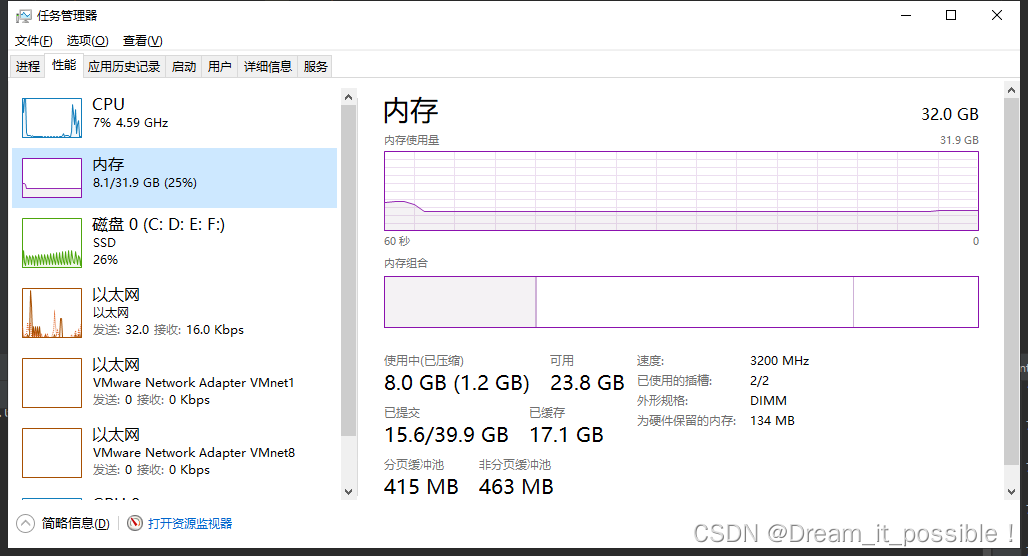
启动后,运行时内存稳定在 11.7G,CPU 稳定利用在 90% 以上。

总耗时由 180 秒缩减到 103 秒,效率提升 75%,得到的结果也与单线程处理的一致。

6. 遇到的问题
如果在运行了的时候,发现 GC 突然罢工不工作了,有可能是 JVM 的堆中存在的垃圾太多,没回收导致内存的突增。
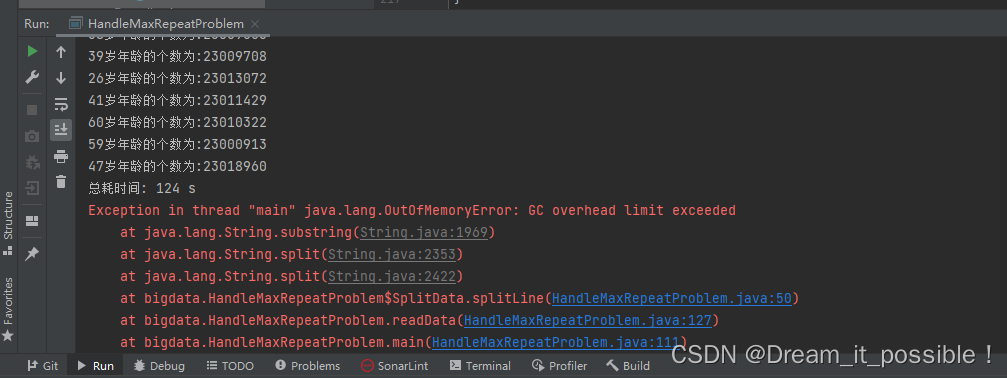
解决方法
在读取一定数量后,可以让主线程暂停几秒,手动调用 GC。
提示: 本 demo 的线程创建都是手动创建的,实际开发中使用的是线程池。
往期热门文章:
1、计算机专业会不会成为下一个土木? 2、xxl-job惊艳的设计,怎能叫人不爱 3、ArrayList#subList这四个坑,一不小心就中招 4、面试官:大量请求 Redis 不存在的数据,从而影响数据库,该如何解决? 5、MySQL 暴跌! 6、超越 Xshell!号称下一代 Terminal 终端神器,用完爱不释手! 7、IDEA 官宣全新默认 UI,太震撼了!! 8、让你直呼「卧槽」的 GitHub 项目! 9、Kafka又笨又重,为啥不选Redis? 10、50多个高频免费 API 接口分享
